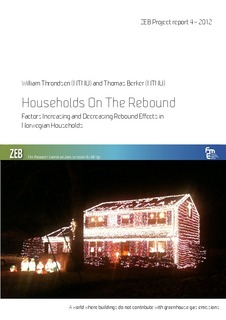| dc.description.abstract | This is a report on a study conducted in the spring of 2011 to examine the cultural and social conditions associated with rebound effects on the household level. The goal of the study was to conduct an empirical, qualitative exploration of the conditions that favour rebound effects. In economics, rebound effects are defined to occur when a measure intended to increase energy efficiency actually contributes to an increase of energy consumption. Examples of conditions that favour rebound effects include using heat pumps for cooling, leaving energy‐saving light bulbs on for longer periods or neglecting to shut them off entirely, or driving an energy efficient car more often at higher speed over longer distances.
To shed light on rebound effects occurring on the household level, in this study we aim at contributing to a better understanding of the meanings that households attach to energy‐saving investments in general and to examine conditions that result in unexpected reductions of the effect of energy efficiency investments. The material for this study was gathered through in‐depth interviews with the representatives of 17 households in the Trondheim region. Each interview lasted about an hour. The majority of the respondents were drawn from a group of approximately 100 households that had received funding from Enova SF to procure technology for improving energy efficiency. In the interview, we asked respondents about their commitment to the environment, energy practices, energy technologies and their relationship to the energy bill and their energy supplier/utility company. In particular, to identify situations where rebound effects might arise, we examined respondents’ reports on their experiences of introducing energy efficient technology into their household, their everyday energy practices, and the ways in which this new technology forced or warranted change in their energy consumption behaviour.
This report consists of three parts: a chapter that proposes definitions and operationalization of rebound effects on the household level, a chapter on observations made about respondents’ experiences of investing in energy efficient technology, and a chapter on the factors located within the household that tend to interfere with the effect of the investments. The latter two chapters have their own sections that summarise the respective major findings. | |
